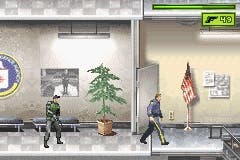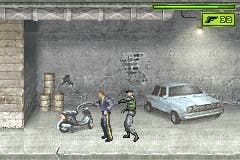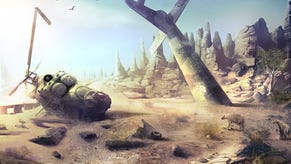Splinter Cell
It takes a heck of a lot to secrete Tom anywhere, but he makes a good handheld Sam Fisher.
You know, we pity the poor developers who get tasked with projects like this. We bet they don't ask for them. But these days, whether it's a 3D platformer or a complicated tactical shoot 'em up and spy sim, the publisher behind the purse strings always seems to want a GBA conversion. Ubi Soft is no exception. And that's why we should all be upstanding for the publisher's Montreal development studio, whose efforts have - against the odds - created damn near the best 2D sneak 'em up we've ever played.
Diddy Covert

2D approximations of successful console games often try to encapsulate what's good about their elder siblings, and Splinter Cell's GBA outing is no exception. The handheld version of Sam Fisher can do all the usual spy/hero crap - walking (direction) running (double-tap direction), jumping (A), hanging from ledges, clambering up and sliding down ladders and pipes, knocking people out with his fist (B), raising and lowering his weapon (L) and shooting people with it (L then B) - but he can also take advantage of a special intelligence-gathering camera, accessed by holding R, which lets the player pan around the screen with the directional pad, spying on guard positions and the various security cameras' sweeping fields of vision.
Sam can also interact with much of the environment by pressing up on the directional pad at various points. When a shadowy enclave becomes apparent, Sam can duck into it, allowing him to hang around without alerting anyone, and if the lights go out or complex infrared security is in place, he can flick on night vision or thermal vision via the Start menu.
Each of the GBA version's ten levels mimics the objectives and settings of the original version, from the training mission inside the NSA to the CIA infiltration, Caspian Sea Oil Refinery and beyond. The only difference is that everything's in side scrolling 2D. It's still usually a case of avoiding detection, knocking guards out when they're not looking, finding key cards and picking your way through locks and safes. These sections are handled with cute little mini-games, played against the clock, where Sam has to either tap bits of the lock in order by moving his picking device in and out and pressing up and down, or rotate the safe lock cylinders with L and R before inserting the bolt to open them. Variations on this theme (for disarming sentry guns etc) pop up later on.
Light and shadow

Visually the game is obviously nothing like its console counterparts, but Ubi Soft has done a pretty respectable job. Characters and character animations seem a few frames short of ideal, but Sam himself moves both crouched and upright with the same sort of precise, every-step-could-give-him-away subtlety, and runs like all hell's broken loose. The rest of his animation is pretty good, too - from swinging himself hand over hand along bars, legs wrapped around them or not, to climbing onto platforms and raising/lowering his gun. However there are some problems here - his bang-on-the-head animation, for example, looks more like a sort of exaggerated, comedy bonk than an incapacitating blow.
Fortunately Sam's environments and enemies are varied and detailed enough that you don't really notice any problems. There are plenty of different enemy models, and some of them dart quickly around, while some stand and glance over their shoulder occasionally. Others still patrol with weapons under their arms, or stand in the background overlooking a particular opening, occasionally turning away. But they do uniformly look like guards, which was presumably the aim.
The levels for their part are very static, with the exception of the occasional blinking light or lick of flame (particularly during the well-realised race through the burning house), but otherwise all we're dealing with is limited camera movement and painted backgrounds - nice, detailed, painted backgrounds, but as you can see them in the screenshots (hopefully), there isn't much point going into specifics. Occasionally there are two layers of depth, but this only applies to guards patrolling behind objects and so on, and you can't head back there yourself. Presumably Ubi felt this would be too confusing.
Splinter Hell

On the whole, then, what we have is a compromise - the faithful inclusion of much of Sam's stealth armoury (right down to his smoke grenades, night vision and light meter) playing off against the obvious restrictions of a 2D world, but in all honesty, the thing that most annoys the player is nothing to do with the technology. It's silly little things, like the way some guards spot you as soon as you stray within 50 yards of them, but others still can stand on the same screen as you, looking right at you, without a clue in the world. And some of the level design is ludicrously bad - the middle section of one level about two thirds through the game has you chasing a chap across an obstacle course of boxes, overhead rails and pitfalls, and it seems almost purposely designed to emphasize the game's flaws!
By the time you finish this section, you'll be cursing the way you have to slow down to walking pace to fire your gun (useless when he just runs off the screen before you can get a shot off), the forced momentary pause between getting to the end of a rail and being able to jump off it, and having to double-tap a direction in order to run. Yes, in general this is a perfectly good system, but it is quite the opposite when you need to be running constantly - regardless of slowing to shoot, jumping from rails etc - in order to stand any chance of catching a fugitive.
We can put up with replaying sections of the levels if the process merely requires thoughtfulness and patience, but we can't stand that sort of crap. Fortunately the game's automatic save points are reasonably well-placed, and usually only peg you back a few minutes - although you do have to restart a level completely if you turn off the GBA and come back to it later.
Silent Cell
Splinter Cell on the GBA is very playable at times. It's never as tense as its console sibling, and it suffers from a few frustrating flaws, but the core sneak 'em up gameplay - evading enemies and cameras, silencing alarms, collecting data and using your spy tools - is well represented. Ubi has even thrown in some neat little sub-games like the aforementioned lock picking, and a Silent Scope-esque covert photography element midway through the game. Our main concern is that it won't last you anywhere near as long as the console version, but if you're looking to buy the Cube version as well, then you can download a further five levels using the link-up cable. Without that though, we made it to the eighth GBA level of ten in just under four hours, and half the time we were actually slightly inebriated [fired! - Ed]. Regardless though, if you simply want something sneaky to play on your handheld, and can put up with foolish game design from time to time, then you're in for a covert treat.



